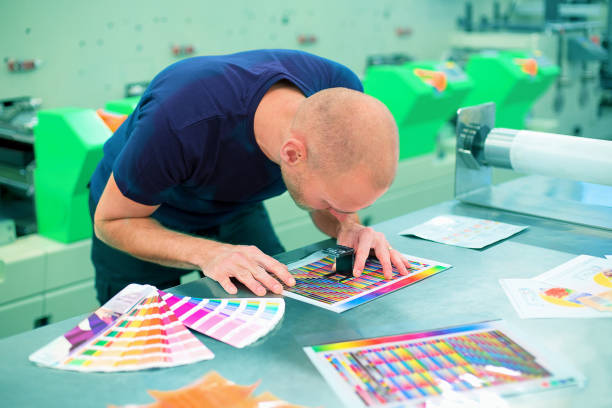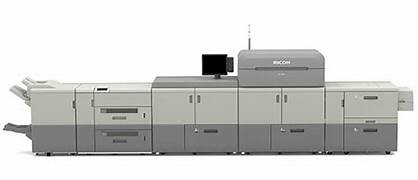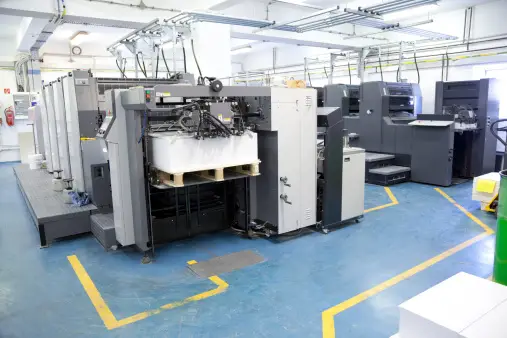
In the world of flyer printing, there are two popular methods to choose from: digital printing and offset printing. Each method has its own set of advantages and considerations, making the decision of which one to use for your project an important one.
In this article, we will explore the differences between digital and offset printing for flyers and help you determine which printing method is most suitable for your project. We will discuss the advantages and disadvantages of each method, as well as considerations such as print quality, cost efficiency, professional service, environmental impact, flexibility, reliability, turnaround times, and paper stock options.
Key Takeaways:
- Digital printing and offset printing are two popular methods used for flyer printing.
- Understanding the advantages, disadvantages, and considerations of each method is crucial in making the right choice for your project.
- Factors to consider include print quality, cost efficiency, environmental impact, flexibility, reliability, turnaround times, and paper stock options.
- Both digital and offset printing have their unique strengths, so it’s important to evaluate your project requirements before making a decision.
- By understanding the differences between digital and offset printing, you can make an informed choice that meets your specific needs and goals.
Understanding the Basics of Flyers Printing
Before we delve into the differences between digital and offset printing, it is important to have a basic understanding of flyer printing. In this section, we will discuss the flyer printing process, including design considerations and different printing techniques used in the industry.
When it comes to flyer printing, the process involves several key steps. Firstly, the design of the flyer plays a crucial role in attracting attention and conveying the intended message. A well-designed flyer should effectively communicate the purpose of the promotion and be visually appealing to the target audience. Elements such as color scheme, typography, and imagery all contribute to the overall impact of the flyer.
Once the design is finalized, the next step is to choose the printing technique that best suits the project requirements. There are various printing techniques available, each with its own advantages and considerations. Digital printing, for example, utilizes toner-based technology or inkjet technology to produce high-quality prints quickly and efficiently. On the other hand, offset printing, a traditional method, involves transferring ink from a plate to a rubber blanket before applying it to the paper.
When selecting a printing technique, factors such as print quality, cost efficiency, and turnaround time should be taken into account. Digital printing, with its ability to reproduce sharp, vibrant colors, is often preferred for shorter print runs or projects that require personalization. Offset printing, on the other hand, excels in producing large quantities of flyers with consistent quality and is more cost-effective for longer print runs.
In addition to the printing technique, choosing the right paper stock and finishes also plays a crucial role in flyer printing. The type of paper used can enhance the overall look and feel of the flyer, as well as impact its durability. Options such as glossy and matte papers offer different effects, with glossy paper providing a shiny, reflective finish and matte paper offering a more subdued, non-reflective surface. Moreover, considering the environmental impact, choosing recycled paper can align with sustainability efforts and cater to eco-conscious consumers.
In conclusion, understanding the basics of flyer printing involves considering design considerations, exploring various printing techniques, and selecting the appropriate paper stock and finishes. In the next section, we will delve into the emergence of digital printing and its advantages in flyer production.
The Emergence of Digital Printing

With the rapid growth of digital printing technology, businesses now have a more convenient and efficient way to produce high-quality flyers. Digital printing has become increasingly popular in recent years due to advancements in toner-based and inkjet technologies.
How Digital Printing Works
Digital printing involves the process of transferring digital files directly to a digital printing press, bypassing the need for traditional printing plates. This method allows for faster turnaround times and eliminates the setup costs associated with offset printing.
Advantages of Using Digital Technology
Digital printing offers numerous advantages over traditional offset printing. One of the key advantages is speed, as digital presses can produce prints at a much faster rate. This is especially beneficial for businesses with tight deadlines or last-minute printing needs.
Another advantage is the versatility of digital printing. It allows for easy customization and personalization, making it ideal for targeted advertising and promotional materials. Digital presses can also accommodate lower minimum quantities, making it cost-effective for small print runs.
Applications Suited for Digital Printing
Digital printing is suitable for a wide range of applications, including flyers, brochures, business cards, posters, and more. It is particularly well-suited for materials that require frequent updates or customization, such as event flyers or personalized direct mail campaigns.
Common materials printed using digital printing include paper-based products such as flyers, postcards, and booklets. However, digital printing technology has also advanced to allow printing on various materials, including synthetic stocks, fabric, and even metal.
| Materials commonly printed using digital printing: |
|---|
| Paper |
| Flyers |
| Postcards |
| Brochures |
| Business cards |
| Posters |
| Booklets |
| Synthetic stocks |
| Fabric |
| Metal |
An Overview of Offset Printing

Offset printing is a traditional method of printing that has been used for many years. It involves transferring ink from a plate to a rubber blanket and then onto the surface. This process is known as offset because the ink is not directly applied to the paper.
Offset printing offers several advantages over digital printing for certain types of projects. It is capable of producing high-quality prints with sharp and vibrant colors. The process also allows for more precise color matching and better consistency from print to print.
One of the key benefits of offset printing is its ability to handle large print runs. It is a cost-effective option for printing in bulk, making it suitable for projects that require a high volume of flyers.
However, there are some downsides to offset printing. It typically has a longer setup time compared to digital printing, which can affect turnaround times. Additionally, offset printing requires the creation of printing plates, which can add to the initial setup costs.
Here is a comparison between offset printing and digital printing:
| Offset Printing | Digital Printing |
|---|---|
| Produces high-quality prints | Offers fast turnaround times |
| Suitable for large print runs | Cost-effective for small quantities |
| Requires setup time and printing plates | No setup time or printing plates |
| Allows for precise color matching | Offers variable data printing |
Overall, offset printing remains a reliable and widely used method for printing flyers, especially for large print runs that require high-quality results. However, for smaller quantities or projects with quick turnaround times, digital printing may be a more suitable option.
Comparative Analysis: Print Quality and Resolution
When it comes to printing flyers, one important aspect to consider is the print quality and resolution. The choice between digital printing and offset printing can have a significant impact on the final output of your flyers. Let’s take a closer look at how these two printing methods compare in terms of print quality and resolution.
Digital Printing: Digital printing offers excellent print quality, especially for small to medium print runs. The technology used in digital printing allows for precise color reproduction and sharp text and images. The resolution in digital printing is measured in dots per inch (DPI), and modern digital printers can produce high-resolution outputs that rival offset printing.
Offset Printing: Offset printing is known for its exceptional print quality, particularly for large print runs. This traditional printing method uses plates and ink rollers to transfer ink onto the paper, resulting in vibrant colors and detailed imagery. With offset printing, the resolution is typically higher compared to digital printing, providing a crisp and professional look.
Factors such as the type of paper used, the expertise of the printing company, and the design of the flyer can also influence the print quality and resolution. It’s important to work with a reputable printing service that uses high-quality equipment and offers a wide selection of paper options to achieve the desired print quality and resolution for your flyers.
| Digital Printing | Offset Printing | |
|---|---|---|
| Print Quality | Excellent | Exceptional |
| Resolution | High, measured in DPI | Higher compared to digital printing |
| Suitable for | Small to medium print runs | Large print runs |
As seen in the comparison table, both digital printing and offset printing have their strengths in terms of print quality and resolution. If you require high-quality prints for a small to medium quantity of flyers, digital printing is an excellent choice. On the other hand, if you need to produce a large number of flyers without compromising on print quality, offset printing is the preferred method.
Next, we will explore the cost efficiency of digital and offset printing, helping you make an informed decision for your printing needs.
Cost Efficiency: Digital vs. Offset Printing
When it comes to choosing a printing method, cost efficiency is a crucial factor to consider. In this section, we will dive into the cost analysis of digital and offset printing, including how to calculate printing expenses for different quantities. We will also explore the economic advantages of digital printing and highlight the break-even point for offset printing.
Calculating printing expenses involves taking into account various factors such as setup costs, materials, labor, and additional services. For small to medium-sized print runs for both single and double sided printing, digital printing generally proves to be more cost-effective due to its lower setup costs and ability to print on demand. On the other hand, offset printing becomes more economical for large-scale print runs, thanks to its high-speed production capabilities and lower costs per unit for bulk orders.
One of the economic advantages of digital printing is its ability to minimize waste by allowing for smaller print quantities without incurring additional costs. With digital printing, you have the flexibility to print only the quantity you need, thereby reducing excess inventory and saving on storage costs. This is particularly beneficial for businesses with fluctuating print demands or those looking to test multiple design variations before committing to a larger print run.
Offset printing, on the other hand, has a break-even point that can yield significant cost savings for larger print runs. While the initial setup costs for offset printing may be higher, the cost per unit decreases as the quantity increases, making it a viable option for organizations that require high-volume printing on a regular basis. Additionally, offset printing offers a wide range of paper stock options, coatings, and finishes, allowing for more customization and added value to your flyers.
Cost Efficiency Comparison: Digital vs. Offset Printing
To provide a clearer comparison between digital and offset printing, let’s take a look at a cost efficiency analysis for different print quantities:
| Print Quantity | Printing Method | Average Cost per Unit | Total Printing Expense |
|---|---|---|---|
| 500 | Digital Printing | $0.50 | $250 |
| 1,000 | Digital Printing | $0.45 | $450 |
| 5,000 | Offset Printing | $0.10 | $500 |
| 10,000 | Offset Printing | $0.08 | $800 |
As seen in the table above, digital printing costs per unit remain relatively consistent, offering better cost efficiency for small to medium-sized print quantities. However, offset printing becomes highly cost-effective for larger print runs, where the cost per unit significantly decreases, resulting in substantial savings.
Ultimately, the decision between digital and offset printing depends on your specific printing needs, budget, and desired outcomes. It’s important to carefully analyze the cost efficiency of each method and consider factors such as print quantity, customization requirements, turnaround times, and quality expectations.
Environmental Concerns in Modern Printing Practices

With the growing focus on sustainability, it is essential to understand the environmental impact of printing. This section will explore the environmental concerns associated with modern printing practices, comparing the sustainability of digital printing and offset printing.
The Flexibility of Digital Printing
Digital printing offers a high level of flexibility compared to offset printing. This versatility makes it a popular choice for various printing projects, including flyers. Let’s explore the different aspects of digital printing that contribute to its flexibility.
Variable Data Printing
One of the key advantages of digital printing is its ability to handle variable data printing. This means that each flyer can be customized with unique text, images, or other content elements. With digital printing, you can easily personalize your flyers by incorporating individual names, addresses, or other personalized information on each printed piece. This dynamic feature is particularly useful for targeted marketing campaigns, event invitations, or any project that requires personalized communication with the audience.
Wide Range of Paper Sizes and Finishes
Digital printing also offers immense flexibility in terms of paper sizes and finishes. Whether you need small or large flyers, digital printers can accommodate a wide range of sizes to suit your specific requirements. Additionally, you have the freedom to choose from various paper finishes, such as glossy, matte, or satin, to achieve the desired look and feel for your flyers. The flexibility in paper options enables you to create flyers that are visually appealing and align with your branding.
To summarize, digital printing provides the flexibility to incorporate variable data printing and offers a vast selection of paper sizes and finishes. These capabilities make digital printing a reliable and versatile choice for flyer production.
The Reliability of Offset Printing for Flyers
When it comes to flyer printing, reliability is a crucial factor to consider. While digital printing offers flexibility, offset printing is known for its consistent and dependable results. This is particularly important for large print runs, where reliability becomes paramount in delivering a high-quality end product.
Offset printing utilizes a tried and tested process that has been refined over many years. The method involves transferring ink from a plate to a rubber blanket, which then applies the ink onto the paper. This process ensures precise color reproduction and sharp details, resulting in vibrant and professional-looking flyers.
One of the key advantages of offset printing is its ability to consistently produce high-quality prints. Unlike digital printing, which can be affected by variations in ink levels and equipment performance, offset printing provides reliable and consistent results, ensuring that each flyer is printed with the same level of perfection.
Offset printing is also well-suited for large print runs. The method is highly efficient and can handle high volumes of printing without compromising on quality. Whether you need hundreds or thousands of flyers, offset printing can deliver consistent results throughout the entire print run.
In summary, the reliability of offset printing makes it an excellent choice for flyer printing, especially for large print runs. The method offers consistent and high-quality results that ensure your flyers will grab attention and leave a lasting impression.
| Key Points |
|---|
| Offset printing is known for its reliability and consistent results. |
| This method is particularly suitable for large print runs. |
| Offset printing ensures precise color reproduction and sharp details. |
Turnaround Times: Planning Your Flyer Production Schedule
When it comes to flyer printing, turnaround time is a crucial factor to consider. The production schedule plays a significant role in ensuring that your flyers are ready in time for distribution. Understanding the differences in turnaround times between digital and offset printing can help you plan your production schedule effectively.
In digital printing, the turnaround time is typically shorter compared to offset printing. Digital printers allow for faster setup and minimal prepress work, making it ideal for quick turnaround projects. With digital printing, you can expect your flyers to be produced and ready for pickup or delivery within a few days.
On the other hand, offset printing generally has a longer turnaround time. The offset printing process involves more intricate setup and preparation, which can add extra time to the production schedule. Depending on the complexity of your project and the printer’s workload, it can take anywhere from a few days to a couple of weeks to complete an offset printing job.
When planning your flyer production schedule, it is essential to consider the specific turnaround times for both digital and offset printing. Evaluate the urgency of your project and the desired delivery date. If you have a tight deadline or require quick turnaround, digital printing can be the best option. However, if time is not a significant constraint, offset printing might be suitable, especially for large print runs. And make sure you are supplying print ready artwork for your marketing material. If you aren’t supplying print ready files, the art may have errors and be returned for correction, lengthening the process.
It’s also worth noting that some printing companies offer expedited printing services, which can significantly shorten the turnaround time for both digital and offset printing. However, expedited services often come at an additional cost, so be sure to factor that into your budget. Discuss your timeline requirements with the printing company to determine the feasibility of meeting your desired delivery date.
In conclusion, understanding the turnaround times when you print flyers can help you plan your production schedule effectively. Consider the specific time frames for digital and offset printing when selecting the right method for your project. Whether you need quick turnaround or have more flexibility, there is a printing option that can meet your requirements.
Selecting the Right Paper Stock and Finishes for Your Flyers

The choice of paper stock and finishes can greatly impact the final look and feel of your flyers. In this section, we will explore the options available for paper stock, including glossy and matte papers. We will also discuss the importance of using recycled paper to support sustainability efforts in flyer printing.
Options in Glossy and Matte Papers
When selecting premium paper stock for your marketing materials, you have the choice between glossy and matte papers. Glossy paper offers a smooth and shiny finish, enhancing the colors and images on your flyers. This type of paper is ideal for designs that require vibrant colors and high-definition images to make a strong visual impact. On the other hand, matte paper provides a non-reflective and more subdued finish, resulting in a sophisticated and elegant look. It is suitable for designs that prioritize a softer and more understated aesthetic.
Using Recycled Paper to Support Sustainability
In the era of increasing environmental awareness, using recycled paper for flyer printing is a responsible and sustainable choice. Recycled paper is made from post-consumer waste, reducing the demand for new paper production and minimizing the environmental impact. By opting for recycled paper, you can contribute to the preservation of natural resources and help reduce waste. Additionally, the use of eco-friendly paper options demonstrates your commitment to sustainability and can resonate with environmentally conscious consumers.
Customization Potential with Digital vs. Offset Printing
When it comes to flyer printing, customization is a key consideration. Both digital and offset printing methods offer various options for customization and personalization. Let’s explore the customization potential of each method and compare their capabilities.
Personalization Options:
With digital printing, you have the advantage of easily personalizing each flyer with unique information such as names, addresses, or special offers. This is particularly useful for targeted marketing campaigns and creating a more personalized experience for your audience. On the other hand, offset printing may require additional steps and costs for personalized information.
Level of Flexibility:
Digital printing provides a high level of flexibility, allowing you to make changes to your design more easily and quickly. This is especially beneficial if you need to make last-minute edits or updates to your flyer. Offset printing, while less flexible, offers its own advantages, especially for larger print runs where consistency and efficiency are priorities.
Overall, the choice between digital and offset printing depends on your specific customization needs. If personalization and flexibility are essential, digital printing may be the preferred option. However, if you prioritize consistency and efficiency for larger print runs, offset printing may be the better choice.
| Digital Printing | Offset Printing | |
|---|---|---|
| Personalization Options | Easy to personalize each flyer with unique information | May require additional steps and costs for personalization |
| Level of Flexibility | High level of flexibility for making changes quickly | Less flexible but offers consistency for larger print runs |
By considering the customization potential of digital and offset printing, you can make an informed decision to meet your specific flyer printing requirements.
Conclusion
After exploring the differences between digital and offset printing for flyers, it is clear that both methods have their advantages and considerations. To choose the right printing method for your flyers, it is important to consider several factors.
First, consider your print quality requirements. Digital printing offers excellent quality, especially for short print runs and projects that require personalized content. On the other hand, offset printing is known for its exceptional print quality, making it ideal for large print runs and projects that demand consistent results.
Second, cost efficiency is a significant consideration. Digital printing is cost-effective for small to medium quantities, while offset printing becomes more economical for larger quantities, typically surpassing the break-even point.
Lastly, think about your specific project needs, such as turnaround time, flexibility, and environmental impact. Digital printing provides quick turnaround times, versatility in handling variable data printing, and sustainability benefits through reduced waste. However, offset printing offers reliability for large print runs and a wide range of paper stock options.
To make the right decision, carefully evaluate your printing project requirements and weigh the advantages and considerations of each method. By considering print quality, cost efficiency, project needs, and environmental impact, you can confidently select the best printing method for your flyers.
FAQ
What is the difference between digital and offset flyers printing?
Digital printing uses digital technology to print directly from digital files, while offset printing involves transferring ink from a plate to a rubber blanket and then to the printing surface. Digital printing is more suitable for small print runs and customization, while offset printing is ideal for large quantities and consistent results.
What are the advantages of digital printing for flyers?
Digital printing offers speed, versatility, personalization options, lower minimum quantities, and cost-effectiveness compared to offset printing. It is also well-suited for materials that require quick turnaround times and produces vibrant colour flyers
What are the advantages of offset printing for flyers?
Offset printing is known for its reliability and is ideal for large print runs. It produces high-quality prints with crisp details and vibrant colors. Offset printing also offers a wide range of paper stocks and finishes to choose from.
How does the print quality compare between digital and offset printing?
While both digital and offset printing can produce high-quality prints, offset printing generally provides better color accuracy and sharpness. However, digital printing has made significant advancements and can now achieve exceptional print quality.
Which printing method is more cost-effective, digital or offset?
Digital printing is more cost-effective for small to medium quantities, while offset becomes more economical for large quantities. Offset printing has a higher initial setup cost but can offer lower printing costs for large runs.
What is the environmental impact of digital and offset printing?
Offset printing traditionally requires more resources and produces more waste than digital printing. However, both printing methods have made efforts to reduce their environmental impact, and using recycled paper stocks can further support sustainability in flyer printing.
Is digital printing more flexible than offset printing for flyers?
Yes, digital printing offers greater flexibility than offset printing. It can handle variable data printing and accommodate a wide range of paper sizes and finishes.
Is offset printing more reliable than digital printing for flyers?
Yes, offset printing is known for its reliability, especially for large print runs. It delivers consistent results and is the preferred choice for companies that require precise color matching and quality control.
Which printing method has faster turnaround times, digital or offset?
Digital printing generally has faster turnaround times than offset printing. Due to its streamlined process and lack of setup time, digital printing allows for quicker production and delivery of flyers.
What are the options for paper stock and finishes for flyers?
You can choose from a range of paper stocks for your flyers, including glossy and matte papers. Glossy papers provide a shiny finish, while matte papers offer a more subdued look. Selecting recycled paper is also an eco-friendly option to consider.
How can I customize my flyers with digital and offset printing?
Both digital and offset printing offer customization options for flyers. Digital printing allows for variable data printing and personalized content, while offset printing can incorporate special finishes and embossing for a unique look.
How do I choose the right printing method for my flyers?
When selecting a printing method, consider factors such as print quantity, customization needs, budget, turnaround time, and desired print quality. Digital printing is suitable for smaller quantities and quick turnaround, while offset printing is ideal for larger quantities and consistent results.








